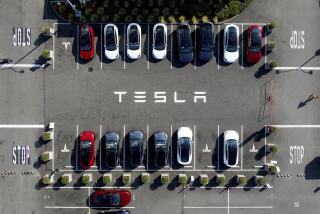First Decline in Several Years : Glut of Used Cars Pushes Prices Down 10% to 15%
- Share via
DETROIT — Last summer, motorists by the score were driving off in all directions from Bill Parker’s used car showroom in Houston.
“Today, it’s almost impossible to sell these late-model cars,” Parker says. “We’re doing less than 40% of what we were doing six months ago. This October and November were the worse I’ve ever seen.”
A. J. Foyt Chevrolet’s used car operation, where Parker is manager, has glum company across the country, experts say.
While new car prices are rising, America is developing a glut of used cars, offering consumers falling prices for the first time in several years.
“We’re seeing 10% to 15% price decreases,” said Howard Tullman, president of Certified Collateral Corp. in Chicago, which operates a nationwide computerized car valuation service. “Some dealers aren’t even putting the price on the car windows.”
Instead, used car dealers are going back to their old props, with whitewashed windshields proclaiming: “Ask Me!” “Wow!” and “Drive Me!” Some are even offering warranties and special loan rates.
The glut is attributed mainly to Detroit’s cut-rate financing and rebate war on new cars in late August and September. Countless Americans traded in their old cars while, at the same time, avoiding late-model used cars in favor of new ones.
“People have been able to buy a new car at a lower price than if they had bought an ’84 used car. Some have had lower monthly payments,” Parker said.
Sales incentives haven’t returned in a big way on 1986 models, but many industry analysts say General Motors, currently suffering sluggish sales, may set off another round of discounting early next year.
A flood of imported economy cars from Japan, South Korea and Yugoslavia is expected next year and will be marketed as substitutes for used cars, further depressing prices.
“A lot of those buyers will be younger people or those who need a second car for running around, and lower-income people,” said Thomas O’Grady of the firm Integrated Automotive Resources in Wayne, Pa.
Families who need a roomy car, however, will remain in the used car market, O’Grady said. With stable gasoline prices and falling sticker prices, they should be able to find good buys.
A typical 1982 option-loaded Chevrolet Citation with 45,000 miles that sold for $3,875 in July sold for $3,450 in November, according to Bill Geen of Certified Collateral. A loaded 1984 Pontiac Fiero with 20,000 miles that sold for $9,250 in July sold for $8,375 in November.
Lynn Weaver, editor of the used car guide from the National Auto Dealers Assn. in McLean, Va., said the trend is returning equilibrium to the business.
Used car prices had been following new car prices--upward--for several years, Weaver said, calling that “an unusual trend.” Traditionally, it’s the other way around, he said.
Another effect of the cut-rate financing translates to “buyer beware.” Al Bruhowzki, used car manager at Bill Brown Ford in Livonia, Mich., said that, out of eagerness to sell, “some dealers made mistakes on the trade-ins. They didn’t put a lot of money in the right cars.”
Parker put it more bluntly. “A lot of rough and edgy used cars” were traded in and are now waiting for buyers, he said.
But, while some dealers consider cut-rate financing, Weird Wally Smith of Lincoln, Neb., bucks the trend, selling about 1,000 cars a year no matter what the economy. His secret: Wally’s Used Cars specializes in models below $1,000, and it’s cash on the cylinder head.
No warranties there. Weird Wally lures buyers another way: He appears in TV commercials starring himself--sometimes clad in his underwear.
“The economy is not a real big factor with us,” Smith said. As for buyer protection, there’s Wally’s 100% No-Fault Warranty: “If the car falls apart, it’s nobody’s fault.”






